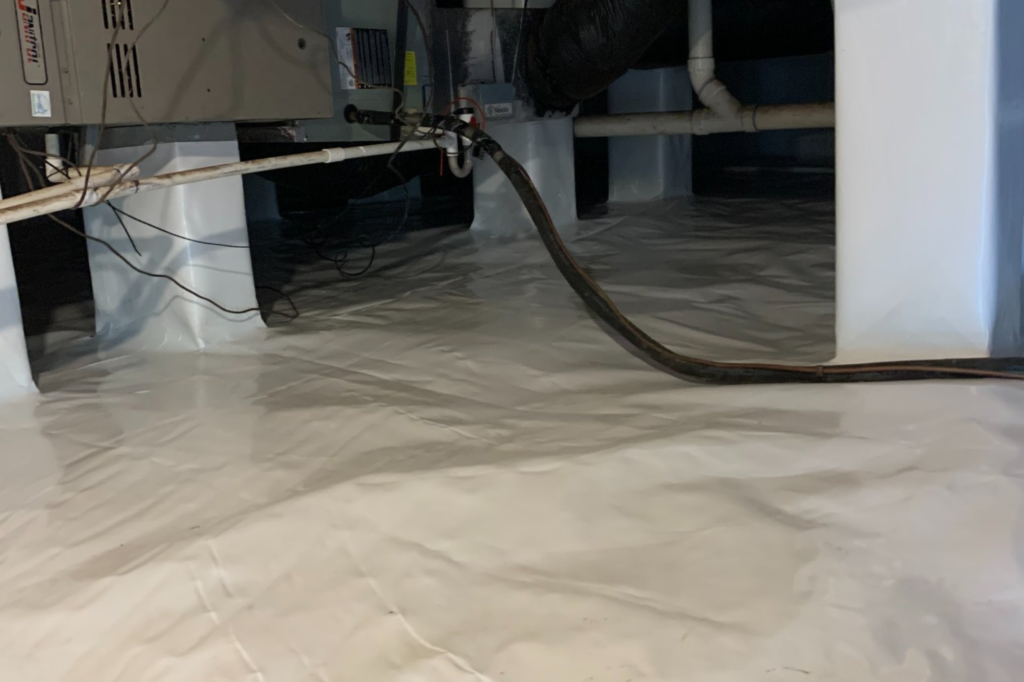Your crawl space might be causing musty odors and contributing to high energy bills. Check for inadequate insulation, as poor sealing allows heat or cold to enter, making your HVAC system work harder. This inefficiency can drive up energy costs by 15-25%. Inspect for signs of mold, such as black or greenish spots, which thrive in humid, poorly ventilated areas. Musty smells often signal moisture issues, so assess for dampness or condensation. Regular inspections can prevent structural damage and respiratory risks from mold exposure. Explore how improving your crawl space can enhance energy efficiency and air quality in your home.
Key Takeaways
- Vented crawl spaces can lead to moisture issues, fostering mold and musty odors.
- Poor insulation in crawl spaces increases energy bills due to heat transfer.
- Air leaks from crawl spaces can account for significant energy loss in homes.
- Musty odors often indicate mold presence, which thrives in humid crawl spaces.
- Professional assessments can identify and resolve crawl space issues impacting home efficiency.
Understanding Crawl Space Issues
When you’re dealing with musty odors or unexpectedly high energy bills, the problem often traces back to issues within your crawl space. Nestled beneath your home, this area serves as a vital hub for plumbing and wiring but is frequently overlooked.
Understanding the intricacies of crawl space issues starts with recognizing the two primary types: vented and conditioned. Vented crawl spaces use airflow to manage moisture levels, while conditioned crawl spaces are sealed and insulated for enhanced energy efficiency.
The condition of a crawl space markedly impacts your home’s energy performance and air quality. Poor insulation can lead to substantial heat transfer, causing your HVAC system to work overtime.
In winter, cold air infiltrates from below, cooling your floors and increasing heating demands. Conversely, in summer, the crawl space can heat up, straining your air conditioning. Additionally, air leaks and inadequate sealing contribute to energy inefficiency, potentially accounting for 15-25% of your home’s energy loss.
Addressing these issues involves understanding the role of moisture control, insulation, and ventilation. By focusing on these areas, you can mitigate musty odors, reduce energy bills, and enhance overall home efficiency.
Identifying Musty Odors
How do you determine if musty odors are emanating from your crawl space? First, take a methodical approach by identifying the source of the smell.
Begin by inspecting the areas closest to the crawl space, such as the lower levels of your home. If the crawl space is the culprit, these areas often exhibit stronger odors. A musty smell usually indicates the presence of mold or mildew, which thrive in damp conditions frequently found in unventilated or poorly sealed crawl spaces.
Check for visible signs of mold or mildew on walls, baseboards, or flooring near the crawl space. These might appear as black or greenish spots.
Don’t forget to examine any stored items, as they can absorb odors and mold spores. Next, assess the crawl space itself. Look for dampness on surfaces or condensation on pipes, which signals excess moisture contributing to the musty smell.
Verify the presence of adequate ventilation. Lack of proper airflow fosters a humid environment, ideal for mold growth. A professional inspection and Richmond VA crawl space encapsulation can help tackle these underlying issues.
Analyzing Energy Bill Spikes
Having identified potential sources of musty odors, it’s logical to turn attention towards unexpected spikes in your energy bills. When you notice these increases, it’s crucial to analyze possible causes within your home, especially your crawl space. A poorly insulated crawl space allows outside temperatures to affect your home’s internal climate, forcing your HVAC system to work overtime. This inefficiency can lead to a substantial rise in heating and cooling costs.
Begin by examining your crawl space insulation. If it’s inadequate or damaged, cold air in winter and hot air in summer can infiltrate your home, making temperature regulation difficult.
Additionally, check for air leaks. Unsealed gaps and cracks allow drafts to enter, further complicating your HVAC system’s workload. Such inefficiencies could account for up to 25% of your home’s energy loss.
Moreover, review your energy bills over time to identify patterns or sudden spikes. Correlate these with changes in weather or crawl space conditions. Consider crawl space encapsulation services Richmond to improve energy performance in the long term.

Moisture and Mold Growth
Moisture is the catalyst that often initiates mold growth in crawl spaces. When humidity levels rise, the damp environment becomes a breeding ground for mold and mildew. This growth isn’t just unsightly; it can also lead to structural damage and health issues.
Mold spores can spread through the air, potentially causing respiratory problems, allergies, and other health ailments for you and your family.
Moisture can enter a crawl space through various avenues. Groundwater seepage, inadequate ventilation, and leaks from plumbing or HVAC systems are common culprits. These moisture sources create a humid environment that encourages mold proliferation.
You might notice musty odors or visible mold patches, signaling that moisture levels are unregulated.
Addressing moisture problems involves identifying and eliminating the source. Regular inspections can help detect leaks and condensation issues early.
Installing moisture barriers, improving drainage, and maintaining proper ventilation are effective strategies to control humidity. By managing moisture levels, you not only prevent mold growth but also protect your home’s structural integrity and maintain a healthier living environment.
Proactively combating moisture guarantees you’re safeguarding your home from the hidden dangers lurking beneath.
Crawl Space Insulation Solutions
Proper crawl space insulation is essential for maintaining energy efficiency and preventing moisture buildup in your home. By insulating your crawl space, you can create a barrier that minimizes heat transfer and air leaks, ultimately reducing energy loss.
Two effective insulation materials are fiberglass batt insulation and spray foam insulation. Fiberglass batts are cost-effective and easy to install, fitting snugly between joists. However, they can absorb moisture, which may lead to mold growth if not adequately managed.
Spray foam insulation, on the other hand, provides excellent coverage and an airtight seal, reducing the risk of moisture intrusion. Its expanding nature fills gaps and cracks, enhancing energy efficiency. However, it’s more expensive than fiberglass and requires professional installation to guarantee proper application.
When insulating, consider the crawl space type. For vented crawl spaces, verify that vents are maintained to prevent moisture accumulation. In conditioned crawl spaces, insulation works best when combined with encapsulation, using a vapor barrier to seal out humidity.
This dual approach boosts energy efficiency and enhances indoor air quality by curbing mold and mildew growth. Choose the right insulation strategy to safeguard your home’s comfort and efficiency.
Professional Assessment and Repair
While addressing crawl space issues can seem intimidating, a professional assessment is a crucial step in diagnosing and resolving underlying problems effectively. Experts use specialized equipment and techniques to pinpoint moisture sources, identify mold growth, and evaluate insulation and ventilation conditions.
They’ll provide a thorough inspection report outlining the issues and suggest tailored solutions to mitigate these concerns. Engaging a professional guarantees you won’t miss hidden problems that could escalate over time.
For instance, they can detect structural damage caused by prolonged moisture exposure, which might otherwise go unnoticed. Additionally, professionals are adept at evaluating the energy efficiency of your crawl space, identifying potential air leaks and poor insulation that contribute to high energy bills.
Once the assessment is complete, a professional repair service can implement necessary solutions, such as encapsulation, installing vapor barriers, or enhancing insulation. These measures not only address immediate issues but also prevent future complications.
Professionals can also perform mold remediation, guaranteeing a healthier living environment.
In Summary
Addressing crawl space issues can effectively eliminate musty odors and reduce energy costs. Start by identifying moisture sources and checking for mold growth, which can degrade air quality and ramp up HVAC usage. Assess your insulation’s effectiveness and consider professional help for thorough inspection and repair. With these steps, you’ll enhance your home’s air quality and energy efficiency, ensuring a healthier and more comfortable living space while keeping expenses in check. Investing in Richmond VA crawl space encapsulation with Tiger C Construction is one of the most efficient ways to protect your home and your budget.
